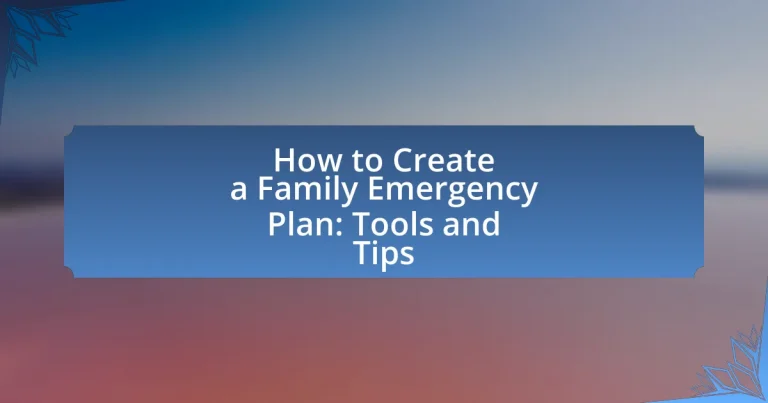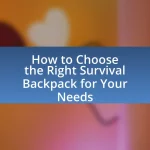A Family Emergency Plan is a structured strategy designed to guide family members in responding to various emergencies, enhancing safety and communication. This article outlines the importance of having such a plan, detailing the types of emergencies it should cover, key components, and methods for effective communication and implementation. It also discusses tools and resources available for creating a Family Emergency Plan, including digital applications and physical kits, while emphasizing best practices and common mistakes to avoid. By following these guidelines, families can significantly improve their preparedness and resilience in the face of unexpected situations.
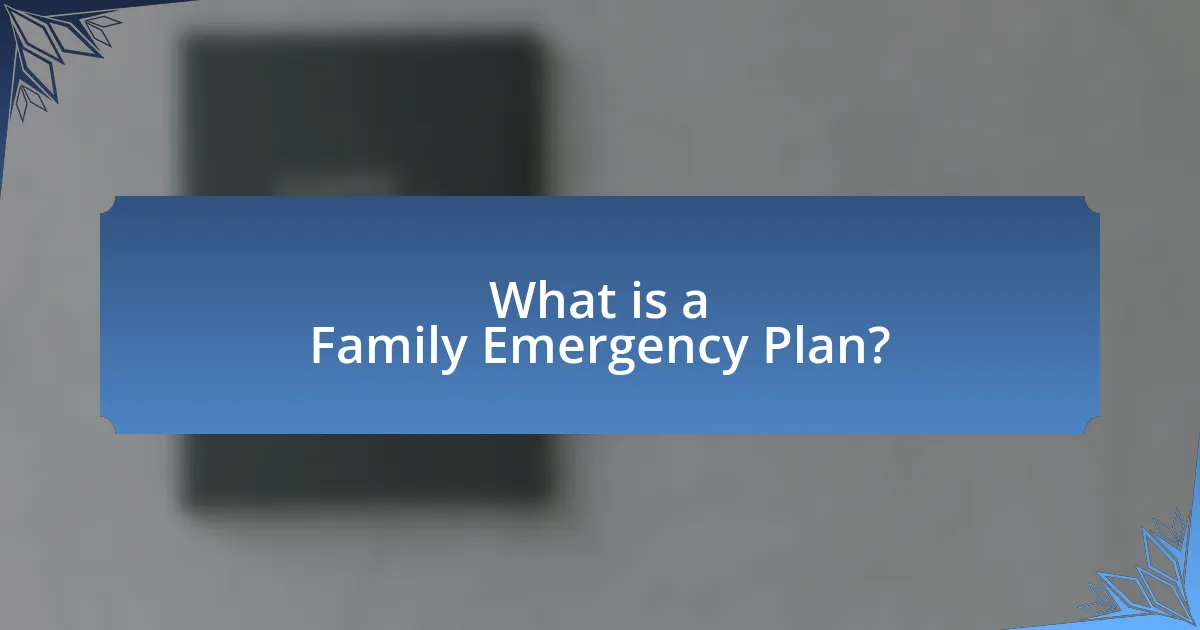
What is a Family Emergency Plan?
A Family Emergency Plan is a comprehensive strategy that outlines how family members will respond to various emergencies, ensuring safety and effective communication. This plan typically includes designated meeting places, emergency contacts, and specific roles for each family member during a crisis. According to the Federal Emergency Management Agency (FEMA), having a Family Emergency Plan can significantly improve preparedness and response during disasters, as it helps families to stay organized and informed.
Why is it important to have a Family Emergency Plan?
A Family Emergency Plan is crucial because it ensures that all family members know how to respond effectively during emergencies, thereby enhancing safety and preparedness. Having a structured plan minimizes confusion and panic, allowing families to act quickly and efficiently in crises such as natural disasters, medical emergencies, or other unexpected events. Research indicates that families with emergency plans are more likely to take appropriate actions during disasters, significantly reducing risks and improving outcomes. For instance, a study by the Federal Emergency Management Agency (FEMA) found that households with emergency plans are better prepared and more resilient in the face of disasters.
What types of emergencies should a Family Emergency Plan cover?
A Family Emergency Plan should cover natural disasters, medical emergencies, technological incidents, and human-caused events. Natural disasters include hurricanes, earthquakes, floods, and wildfires, which can disrupt daily life and require immediate action. Medical emergencies encompass situations like severe injuries or sudden illnesses that necessitate prompt medical attention. Technological incidents involve power outages, hazardous material spills, or cyberattacks that can impact safety and security. Human-caused events include acts of violence, terrorism, or civil unrest, which may require families to evacuate or shelter in place. Each of these categories represents a significant risk that families may face, making it essential to prepare accordingly.
How can a Family Emergency Plan protect your family?
A Family Emergency Plan protects your family by providing clear guidelines and procedures to follow during emergencies, ensuring safety and effective communication. This plan outlines evacuation routes, designated meeting points, and emergency contacts, which minimizes confusion and panic during crises. Research indicates that families with emergency plans are 50% more likely to respond effectively in disasters, as they have pre-established roles and responsibilities. By preparing in advance, families can significantly reduce risks and enhance their overall resilience in the face of emergencies.
What are the key components of a Family Emergency Plan?
The key components of a Family Emergency Plan include communication strategies, evacuation routes, emergency contacts, and a disaster supply kit. Communication strategies ensure that all family members know how to reach each other during an emergency, while evacuation routes provide clear paths to safety. Emergency contacts list important phone numbers for family members, friends, and local emergency services. A disaster supply kit contains essential items such as water, food, first aid supplies, and important documents, ensuring families are prepared for various emergencies. These components are critical for effective response and safety during crises.
How do you identify essential contacts for your Family Emergency Plan?
To identify essential contacts for your Family Emergency Plan, start by listing individuals who can provide support during emergencies, such as family members, close friends, and neighbors. These contacts should be reliable and accessible, ensuring they can assist in various situations like evacuations or medical emergencies. Additionally, include contacts for local emergency services, such as police, fire departments, and hospitals, as well as any relevant community resources like shelters or crisis hotlines. This approach is validated by emergency preparedness guidelines from organizations like the Federal Emergency Management Agency (FEMA), which emphasize the importance of having a clear communication plan and accessible contacts in times of crisis.
What information should be included in an emergency contact list?
An emergency contact list should include the names, phone numbers, and relationships of individuals who can be reached in case of an emergency. This typically encompasses family members, close friends, and neighbors who can provide assistance or information. Additionally, it is important to include the contact information for medical professionals, local emergency services, and any relevant organizations such as schools or workplaces. Having this information readily available ensures quick communication and support during emergencies, which is crucial for effective response and recovery.
How can you effectively communicate your Family Emergency Plan?
To effectively communicate your Family Emergency Plan, ensure that all family members are involved in the discussion and understand their roles. This can be achieved through regular family meetings where the plan is reviewed, practiced, and updated as necessary. Research indicates that families who engage in preparedness discussions are more likely to respond effectively during emergencies, as highlighted by the Federal Emergency Management Agency (FEMA). Additionally, using visual aids, such as maps and checklists, can enhance understanding and retention of the plan.
What methods can be used to share the plan with family members?
To share the plan with family members, utilize methods such as group messaging apps, printed copies, and family meetings. Group messaging apps like WhatsApp or Telegram allow for real-time communication and easy access to the plan. Printed copies ensure that all family members have a tangible reference, which is especially useful in case of power outages. Family meetings provide an opportunity for discussion, clarification, and questions, ensuring everyone understands their roles and responsibilities in an emergency. These methods are effective as they cater to different communication preferences and ensure that the plan is accessible and understood by all family members.
How often should the Family Emergency Plan be reviewed and updated?
The Family Emergency Plan should be reviewed and updated at least once a year. Regular annual reviews ensure that the plan remains relevant and effective, taking into account any changes in family circumstances, such as new members, relocations, or changes in contact information. Additionally, updates should be made whenever there are significant changes in local emergency procedures or resources, ensuring that the family is prepared for any situation.
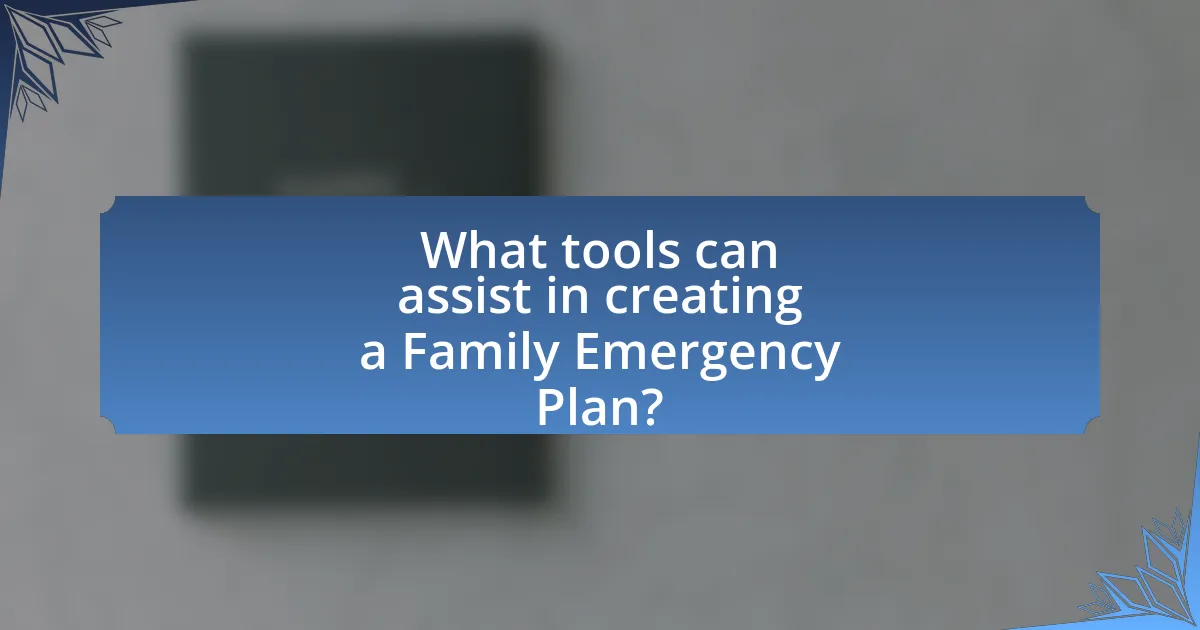
What tools can assist in creating a Family Emergency Plan?
Tools that can assist in creating a Family Emergency Plan include emergency planning apps, checklists, communication tools, and resource guides. Emergency planning apps, such as FEMA’s app, provide templates and resources for developing a plan tailored to specific family needs. Checklists help ensure that all necessary items and steps are covered, while communication tools, like group messaging apps, facilitate coordination during emergencies. Resource guides from organizations like the Red Cross offer comprehensive information on emergency preparedness, including evacuation routes and safety tips. These tools collectively enhance the effectiveness and readiness of a Family Emergency Plan.
What digital tools are available for Family Emergency Planning?
Digital tools available for Family Emergency Planning include mobile applications, online platforms, and cloud-based storage solutions. Applications like FEMA’s app provide real-time alerts, emergency preparedness tips, and a customizable emergency kit checklist. Online platforms such as Ready.gov offer resources for creating family communication plans and emergency contact lists. Additionally, cloud-based storage services like Google Drive allow families to store important documents and information, ensuring access during emergencies. These tools enhance preparedness by facilitating communication and organization in crisis situations.
How can mobile apps enhance your Family Emergency Plan?
Mobile apps can enhance your Family Emergency Plan by providing real-time communication, access to emergency resources, and personalized safety features. These applications allow family members to stay connected during emergencies through messaging and location-sharing functionalities, ensuring everyone is informed and accounted for. Additionally, many apps offer features such as emergency checklists, alerts for severe weather, and access to local emergency services, which can streamline preparedness efforts. Research indicates that families using emergency preparedness apps are more likely to have a comprehensive plan in place, improving their overall readiness for unexpected situations.
What online resources provide templates for Family Emergency Plans?
Online resources that provide templates for Family Emergency Plans include the American Red Cross, which offers customizable templates and guidance on creating emergency plans. Additionally, Ready.gov, a website managed by the Federal Emergency Management Agency (FEMA), provides downloadable templates and checklists to assist families in preparing for emergencies. The Centers for Disease Control and Prevention (CDC) also offers resources and templates focused on health-related emergencies. These organizations are recognized for their expertise in emergency preparedness, ensuring that the templates they provide are reliable and effective for families.
What physical tools should be included in your Family Emergency Kit?
A Family Emergency Kit should include essential physical tools such as a flashlight, multi-tool, first aid kit, whistle, and a portable phone charger. These tools are critical for ensuring safety and communication during emergencies. For instance, a flashlight provides necessary illumination in power outages, while a multi-tool offers various functions for repairs or self-defense. A first aid kit is vital for treating injuries, and a whistle can help signal for help if needed. Additionally, a portable phone charger ensures that communication devices remain operational, which is crucial for contacting emergency services or family members.
What essential items should be in a Family Emergency Kit?
A Family Emergency Kit should include essential items such as water, non-perishable food, a flashlight, batteries, a first aid kit, a multi-tool, personal hygiene items, important documents, and a battery-powered or hand-crank radio. Water is critical, with a recommendation of one gallon per person per day for at least three days. Non-perishable food should sustain the family for at least three days, while a flashlight and batteries provide necessary light during power outages. A first aid kit ensures basic medical needs are met, and a multi-tool offers various functionalities. Personal hygiene items maintain health and comfort, and important documents, such as identification and insurance information, are vital for recovery. A battery-powered or hand-crank radio keeps the family informed during emergencies. These items are recommended by emergency preparedness organizations, including the Federal Emergency Management Agency (FEMA), which emphasizes the importance of being prepared for unexpected situations.
How can you customize your Family Emergency Kit for specific needs?
To customize your Family Emergency Kit for specific needs, assess the unique requirements of each family member, including age, health conditions, and any special needs. For instance, if a family member has allergies, include necessary medications and allergen-free food options. Additionally, consider including items like baby formula for infants, pet supplies for pets, or mobility aids for elderly family members. Tailoring the kit ensures that it effectively meets the diverse needs of your family during an emergency situation.
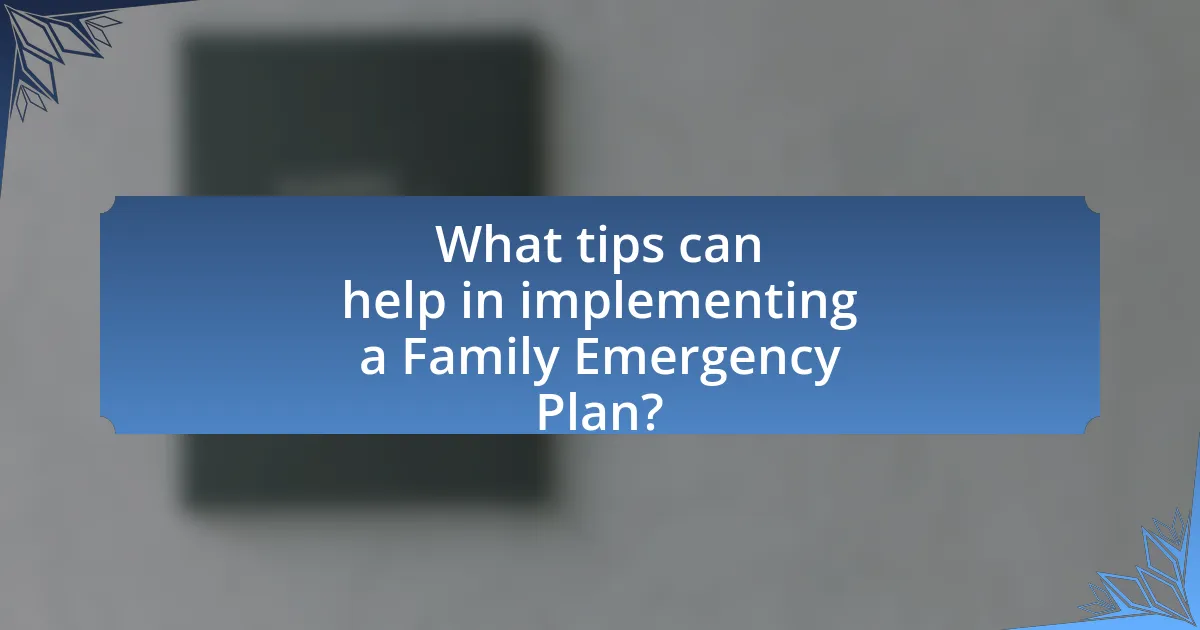
What tips can help in implementing a Family Emergency Plan?
To effectively implement a Family Emergency Plan, families should prioritize clear communication, designate specific roles, and conduct regular drills. Clear communication ensures that all family members understand the plan and their responsibilities, which is crucial during emergencies. Designating specific roles helps streamline actions and reduces confusion, allowing each member to know what to do. Regular drills reinforce the plan, ensuring that everyone is familiar with the procedures and can act quickly when needed. According to the Federal Emergency Management Agency (FEMA), practicing emergency plans can significantly improve response times and overall preparedness.
How can you ensure family members understand their roles in the plan?
To ensure family members understand their roles in the plan, clearly communicate each person’s responsibilities during the planning process. This can be achieved by holding a family meeting where roles are discussed, documented, and assigned based on individual strengths and capabilities. Research indicates that clear communication and role assignment significantly enhance group performance and understanding, as seen in studies on team dynamics. Regularly reviewing the plan and conducting practice drills further reinforces understanding and preparedness, ensuring that each family member is aware of their specific duties in an emergency situation.
What strategies can be used to practice the Family Emergency Plan?
To practice the Family Emergency Plan, families can conduct regular drills, establish communication protocols, and review the plan periodically. Regular drills simulate emergency scenarios, helping family members understand their roles and responsibilities. Establishing communication protocols ensures that all members know how to contact each other during an emergency, which is crucial for coordination. Periodic reviews of the plan allow families to update any changes in contact information or procedures, ensuring the plan remains relevant and effective. These strategies enhance preparedness and increase the likelihood of a successful response during an actual emergency.
How can you address common challenges in executing the plan?
To address common challenges in executing a family emergency plan, ensure clear communication and regular training among all family members. Establishing designated roles and responsibilities helps mitigate confusion during emergencies. Research indicates that families who practice their emergency plans are 50% more likely to respond effectively in real situations, highlighting the importance of drills and discussions. Additionally, maintaining updated contact information and resources can alleviate issues related to accessibility and coordination during crises.
What best practices should be followed when creating a Family Emergency Plan?
To create an effective Family Emergency Plan, families should establish clear communication protocols, designate meeting places, and ensure that all members are familiar with emergency procedures. Clear communication protocols involve identifying how family members will contact each other during an emergency, whether through phone calls, texts, or social media. Designating meeting places, both near home and outside the neighborhood, ensures that family members know where to go if they cannot return home. Familiarity with emergency procedures, such as evacuation routes and emergency contacts, is crucial for a coordinated response. According to the Federal Emergency Management Agency (FEMA), having a plan can significantly reduce panic and confusion during emergencies, leading to better outcomes for families.
How can you make your Family Emergency Plan adaptable to changing circumstances?
To make your Family Emergency Plan adaptable to changing circumstances, regularly review and update the plan based on new information, resources, and family dynamics. This includes assessing potential risks, such as natural disasters or health emergencies, and incorporating changes in family members’ needs or locations. For instance, according to the Federal Emergency Management Agency (FEMA), families should practice their emergency plans at least once a year to ensure everyone understands their roles and can adjust to any new situations effectively. Additionally, maintaining an open line of communication about the plan allows for real-time updates and modifications as circumstances evolve.
What are the common mistakes to avoid when developing a Family Emergency Plan?
Common mistakes to avoid when developing a Family Emergency Plan include failing to involve all family members in the planning process, which can lead to a lack of understanding and preparedness. Additionally, neglecting to regularly update the plan can result in outdated information, such as emergency contacts or evacuation routes. Another mistake is not practicing the plan, as this can leave family members unprepared during an actual emergency. Lastly, overlooking the specific needs of each family member, such as medical conditions or mobility issues, can hinder the effectiveness of the plan. These mistakes can significantly reduce the plan’s effectiveness in a crisis.
